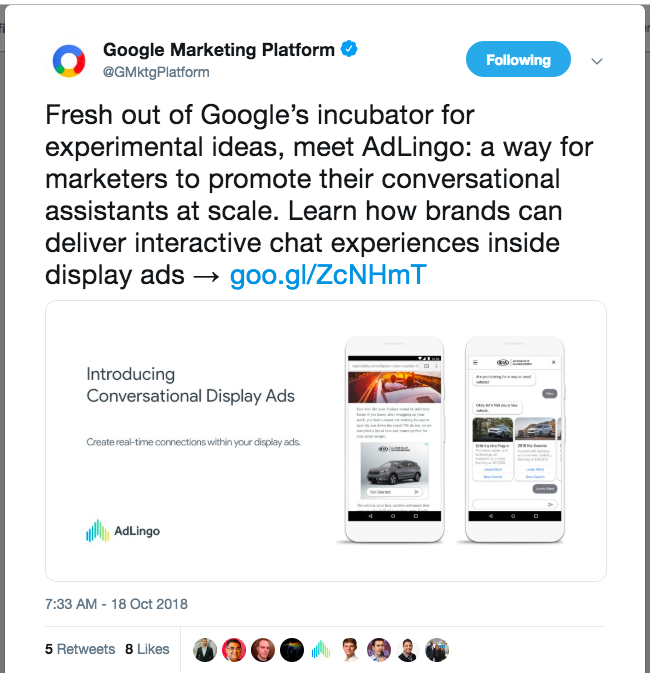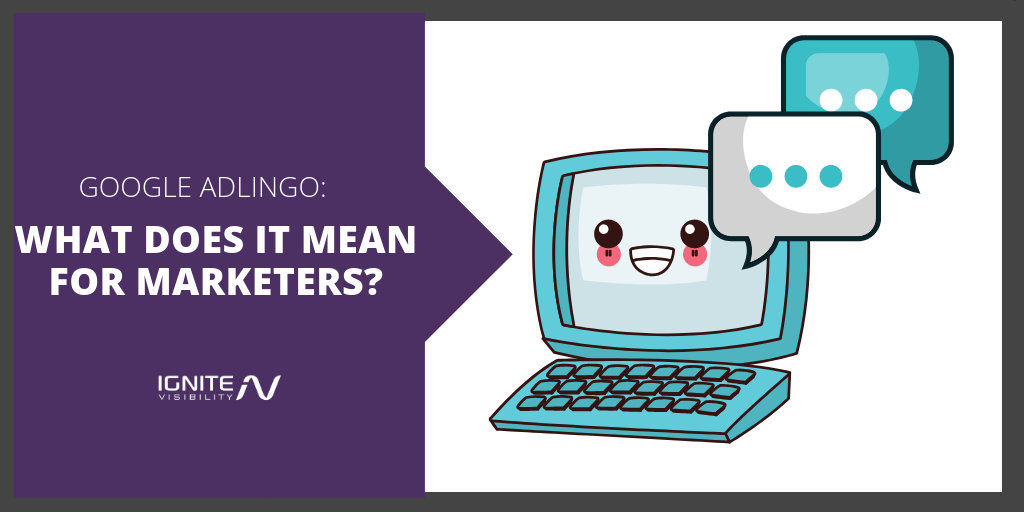Heard the buzz about Google’s latest, AdLingo?
If not, you’re in luck.
I’m about to take you through a full rundown of what Google AdLingo is and what it means for marketers.
Ever wish you could have a conversation with a Google ad?
(Let’s be honest, probably not.)
But whether you wanted it or not, the ability is here.
So think about it this way:
Ever wish you could get more information out of an ad than a clickbait headline? Or maybe get the details that matter most to you, without having to click and search them out on your own?
That’s the beauty of the new AdLingo technology.
And that’s just the tip of the iceberg when it comes to AdLingo.
What is Google AdLingo?
Google AdLingo is a conversational marketing platform that connects users with conversational assistants.
You may know these conversation assistants as chatbots – the digital assistants that live on Facebook Messenger and brand websites, designed to prompt and lead you through real-time conversations.
This new incarnation of advertising tech is being called conversational ads.
They work very similarly to how a chatbot on a webiste would, only Google AdLingo appears in Display ads.
This marks the first time chat format has been available outside of messaging apps for Google Ads users, making it big news for marketers.

Google AdLingo announcement on Twitter
The AdLingo platform was built in Area 120, Google’s incubator for experimental ideas.
Though this is the first time you’ll see this technology generally used, previous experiments have been conducted on Facebook Messenger and, most notably, the industry-first IBM Watson Ads.
While the Watson-powered ads are about as smart as they come, they’re available exclusively on the Weather Channel app and weather.com.
Which once again leaves Google room to pioneer the technology on a broader, widely accessible platform.
How Does AdLingo Work?
To bring chat technology to life on the Display Network, Google’s partnered with three conversational ad providers: marketing intelligence firm Valassis Digital, chatbot provider Take and conversational commerce provider LivePerson.
So Google provides the ad space, and its conversation-based partners power the chat.
As you can see in the example below, the AdLingo ad will appear for searchers on the Display Network with a set prompt.
If the user chooses, they can engage with the ad by clicking. The ad will respond, and start a thread right there without having to move to a website or dedicated landing page.
The ads will function similar to existing Google Ads Display Ads, which means costs will be measured mainly by CPM (cost per impression).
To be clear, AdLingo itself isn’t building the chatbots.
Instead, it integrates with chatbot tools like DialogueFlow, Microsoft Framework, LiveEngage, and Blip, as well as the partners mentioned above.
The cool part is that this ad experience offers more engagement. A user could theoretically chat with your ad for an extended amount of time, with no added charges.
As for what these Google AdLingo ads are capable of, the existing pool is limited.
Early experimenters include AllStar Kia and Tophatter.
Valassis Digital VP of Strategy Mike Balducci does note that most ad responses are canned, meaning it’s not a full-on AI-powered conversation, but features set prompts and responses instead.
But again, it’s still very early days, and we’ll likely see expanding functionality and learning from AdLingo in the near future.
What are the Benefits of Google AdLingo?
To some, the revolution of tech like AdLingo may seem a bit unnecessary.
And it’s easy to think that most consumers won’t want to spend their time interacting with an ad, on the display network, no less.
But in actuality, AdLingo presents some pretty big opportunities for marketers.
The first is that it simply offers better reach and a new way to connect with new customers at scale.
At this time, it’s still a novel idea, which means you can catch many users on intrigue alone. And, because it’s powered by Google’s powerful ad network, you’ll have an incredible way to reach customers at scale.
But one of the biggest benefits AdLingo offers advertisers is the ability to easily converse with new users.
Through these conversations, you’ll be able to gain valuable insight into customer pain points, preferences, major concerns or complaints, etc.
Again, these aren’t just people intentionally seeking out your website or Messenger app. AdLingo gives advertisers access to a wide range of people who fit into their target audience, essentially expanding their ability to chat with an entirely new, qualified audience.
And, because Google AdLingo gives customers the ability to ask questions and find information right there, it could help you close the funnel faster and secure more conversions.
But the benefits here don’t just extend to advertisers. Users will find the AdLingo interface helpful as well.
Specifically, the instant answer approach will be a benefit to users, as it allows them to interact with an ad without clicking through to a new page.

Google AdLingo in action
Beyond that, it offers a more personalized and relevant experience by allowing users to ask the questions and seek the answers most important to them.
On top of that, it’s just kinda cool.
It’s an entirely new way to interact with a brand in an ad interface, and given how well users have taken to chatbots, it only makes sense that they’ll take to the chat/ad combo innovative.
And there’s some backup to prove it.
Kia, one of the early experimenters with Google AdLingo, reports that customers loved having the interactive experience.
Not only that, but enabling users to chat directly with its conversational assistant helped optimize the research and discovery phases of its sales cycle.
“AdLingo lets our customers browse inventory, determine car trade-in value and make an appointment with a salesperson — all within an engaging, interactive experience that meets them right where they are,” said Chris Ferrall, Director of Internet Marketing Allstar Kia.
“By using the platform, we greatly increased the scale of our conversational assistant offering and dramatically reduced the amount of time it took for customers to learn about, consider and purchase our products.”
How Can Marketers Take Advantage of Google AdLingo?
Clearly, Google AdLingo represents a new wave in how we advertise.
But beyond product pushing, Google says AdLingo serves another important purpose.
See, Google realizes that talking to ads is not a top priority for most users, but after a lot of research, they did uncover a big challenge many marketers face: discoverability.
Because apparently, if you build it, they may not come after all.
Though Chatbots are seemingly a dime a dozen these days, going through the time and effort to build one doesn’t ensure it will reach a wide audience.
Advertising, on the other hand, is generally a sure-fire way to reach a wider audience pool. And by combining the two, you can make sure your chatbot isn’t just discovered by those who intentionally visit your website.
So while it’s not necessarily brand awareness (though it certainly can contribute to that), AdLingo helps bring awareness to this way to interact with a brand.
How it’s used specifically will depend on your industry and overall objectives.
Kia, for example, uses its AdLingo ad to let customers browse inventory, determine trade-in values, and make appointments with salespeople. The ability to do all of this in-ad helps contribute to their top-of-the-funnel activity.

Kia is experimenting with Google AdLingo
But these can also be used for more bottom-of-the-funnel, awareness goals.
AdLingo co-founder Vic Fatnani gives the example of a soda company entering a new market, and using AdLingo to entice people to vote on what kind of flavor they’d like.
Just like regular ads, you can customize your Google AdLingo ads to appeal to different buyers in different stages of the cycle.
And, as mentioned above, it can be used to collect valuable intel on your target audience.
Through their interactions with your bot, you can gain insight into the kinds of questions and concerns expressed most.
Based on that information, you can build more relevant ad experiences for your users in the future.
What Google AdLingo Means For Marketing
These days, making a connection with your customers is more important than ever.
In an over-saturated, ad-heavy world, it’s simply not enough to put up an ad and hope it gets a click.
Instead, you need practices like remarketing that can help reconnect with people based on their interests. You need a personalized approach in email and content to make an impression.
In short, you need to engage.
That being the case, it makes sense that technology like AdLingo is the next step in digital advertising.
But there’s more to it than a growing need for a more personalized and engaging experience with a brand.
The fact is that we live in an increasingly AI-focused world.
From a user standpoint, the introduction of chatbots and digital assistants has made it easier than ever to find and gather quick information.
And as we become more accustomed to an AI world, we’ll begin to expect everything to operate with the same ease and accessibility.
That means previously simple tasks like typing out questions and scrolling through search results or even navigating to new web pages could become barriers to entry for many users.
Google certainly hasn’t been shy about its adoption of AI, and in turn, that means that marketers who want to stay relevant will have to adapt to changing technology.
Google thinks that AdLingo is a way for advertisers to do just that.
AdLingo co-founder and general manager Vic Fatnani told TechCrunch, “Everything is becoming more conversational, whether it’s through devices such as your phone, your speaker and eventually your car…We asked ourselves, ‘Hey if this shift is happening, why can’t marketing be more conversational?'”
He continued:
“Conversational assistants are revolutionizing how brands and consumers engage with one another, facilitating real-time, two-way conversations that let brands answer their customers’ most pressing questions. Our new platform is bringing these valuable conversations to the web pages and mobile apps that consumers are already browsing.”
Wrapping Up Google AdLingo
Google’s latest could certainly be a game changer for advertisers.
It’s still in its early days, and how well advertisers and their audiences adapt to the new technology remains to be seen.
I, for one, predict big things from AdLingo, and as AI continues to revolutionize how we market, I recommend advertisers start thinking about how to make Google AdLingo work for them.
